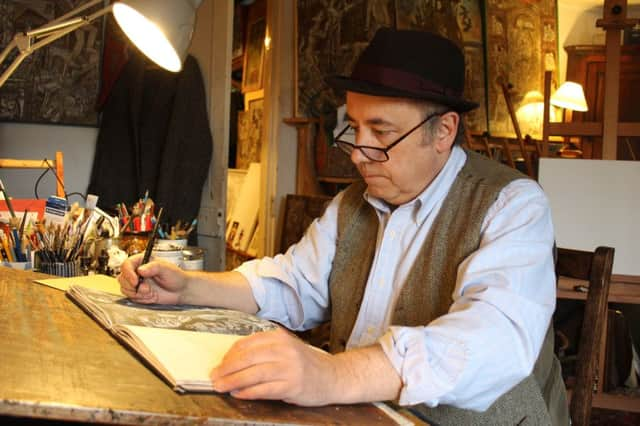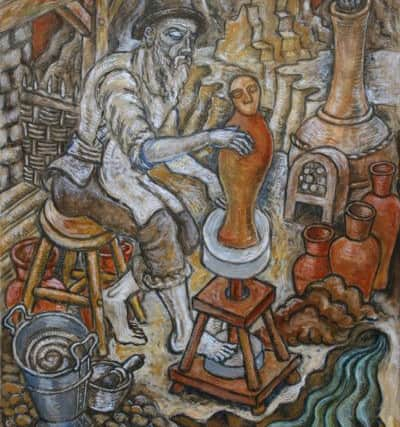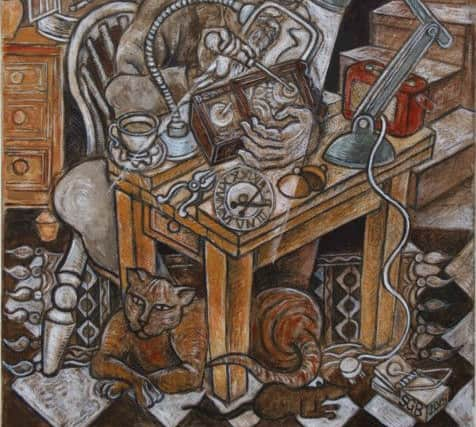The Yorkshire artist who has taken Bible stories and set them in Deptford


That is why Stephen Guyon Bird, the head of art and history of art at Ampleforth College, has spent two years adding to that rich canon with the intention of making us think. He has taken a new approach to the Old Testament with a series of 21 narrative paintings based on the book of Genesis. Most are set between the 1950s and the 1970s in south east London, although the North York Moors and the Hebrides also feature.
The pictures were created on an artistic sabbatical funded by the Farmington Institute, which supports projects that encourage engagement with biblical text, and an exhibition opens at Durham Cathedral on March 3.
Advertisement
Hide AdAdvertisement
Hide AdThere you will see Noah as a boat builder in Deptford Creek in 1970s London before the Thames Barrier breaks. Jacob wrestles with the angel on the side of a Hebridean loch, while Abraham drives a Morris Traveller and the Garden of Eden is the backyard of a terraced house strung with wet washing.


In the creation story, God takes the form of Stephen’s friend, the esteemed potter, Peter Dick, to create Adam from clay and water on a primitive kick wheel.
This unconventional style, developed after studying at Chelsea then Goldsmiths School of Art, is thought provoking and combines theology with his own cultural references and a lot of humour. While oil and acrylic bring colour and depth, drawing is at the heart of the images.
“I grew up reading The Beano and that sense of line and that way of delineating form has stayed with me,” he says.
Advertisement
Hide AdAdvertisement
Hide AdThe Bash Street Kids informed his drawing and his great sense of humour, while The Bible fascinated him. Genesis, he says, has powerful tales of murder, violence, love, loyalty, betrayal, long journeys and homecomings.


“Artists have been painting and rethinking Genesis throughout history,” says Stephen. “I am constantly referring to religious paintings because I teach history of art. We go to Florence with students to see examples from the medieval and early Renaissance period but here, thanks to the Reformation, much of our medieval religious art was destroyed. Those pictures were the poor man’s Bible, as most people couldn’t read. The idea was for me to reimagine them and tell the stories in a different historical context.”
Another motivation was the domination of photographic images in today’s culture and the gradual loss of Bible stories in a more secular society.
“We have a very lens-based view of the world. I wanted to go back to something fundamental, drawing a line around an idea. I also think we are losing some of the stories, which was another reason for revisiting them. A lot of people think Genesis is about Adam and Eve but there is so much more,” he says.
Advertisement
Hide AdAdvertisement
Hide AdHe points to Hagar in the wilderness, which he re-read as a teenager after seeing a “wonderfully tender” Rubens depiction in Dulwich Picture Gallery.


“I took solace in the painting. I used to call into the gallery while visiting my grandmother. London seemed so grey and alienating that it seemed miraculous that this gem of a painting could be available a cycle ride away.
“It is such a rich and complex story that has been largely forgotten about. It also allowed me to tick Moby Dick off the list of must-read novels. ‘Call me Ishmael’ is the opening line,” says Stephen, who painted himself into the background riding his bike, while Abraham is driving off leaving Hagar alone among the fading grandeur of London streets. She is greeted by an angel with a guitar on his back and a feather in his hat. Stephen’s interest has been fuelled by his job and he has collaborated for the exhibition with one of the Ampleforth monks, the biblical scholar Dom Henry Wansbrough, who has written a reflection on each of the paintings for an accompanying catalogue.
“The interesting thing is the way he interprets the images, which is not always what I intended,” says Stephen, who rarely gives himself a day off from painting, not even the Sabbath.
Advertisement
Hide AdAdvertisement
Hide AdHis cottage in Ampleforth is proof of his compulsion to create and, some might say, he was led to the village in a “meant to be” kind of way.


He discovered it after moving from London to York. “I used to cycle up here from York to do drawings of the ruined abbeys. I took a wrong turn and ended up in Ampleforth. I saw the job at the college advertised and thought I could do it for one term. I’ve been there ever since and I love it,” he says.
Genesis: a visual exploration will be in The Chapel of the Nine Altars at Durham Cathedral from March 3 until March 17. The paintings can also be found on the Ampleforth College website.